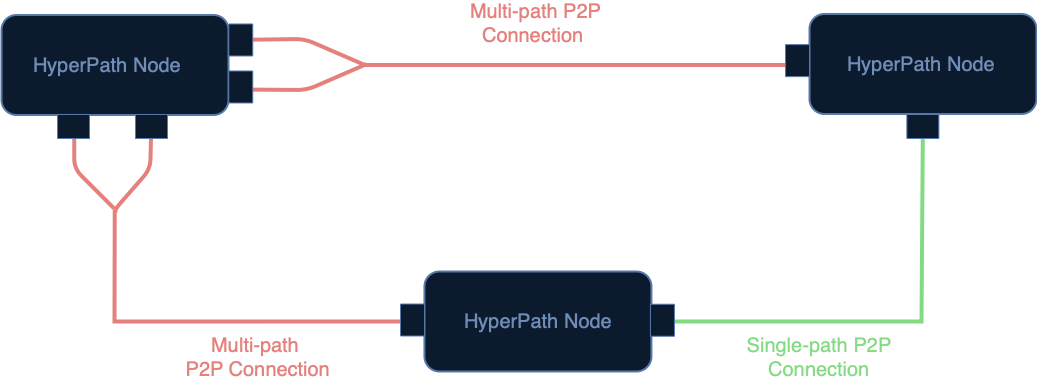What is HyperPath?
Overview
HyperPath is a novel software solution that lets you build an ultra-reliable your connectivity by allowing your devices to use all their links simultaneously to achieve higher speeds, lower latency, and maximum reliability.HyperPath uses its unique multi-connectivity technology as the foundation for creating an ultra-reliable and low-latency Peer-To-Peer (P2P) Virtual Private Network (VPN) called a HyperNet.
A HyperNet combines the security of a traditional VPN with the high-performance and reliability of multi-connectivity, and the low-latency and cost-effectiveness associated with P2P connectivity.
The end result is a virtual network where your devices can communicate reliably, efficiently, and securely, and that is seamless deploy and operate.
Example HyperPath Network (i.e. a HyperNet)
Below is an example of a HyperNet, with 3 nodes, where 2 nodes have one network interface and one node has 2 network interfaces.
All the nodes are connected over P2P connections to each other.
The node with 2 network interfaces initiates a multi-path P2P connection to the other two, allowing it to use all its available network interfaces simultaneously to send and receive data. The other two nodes initiate a single-path P2P connection.

Multi-connectivity
Not just load-balancing or fail-over
Unlike the majority of multi-connectivity solutions currently available, HyperPath's multi-connectivity is not limited to policy-driven flow load-balancing or fail-over.
HyperPath utilizes all available network interfaces simultaneously, even for a single traffic flow, using its multi-path scheduling algorithms. For example, HyperPath can replicate traffic from a single video stream over multiple network interfaces to mitigate even the most brief fluctuations or outages caused by mobile network handovers or cross-traffic.
Currently HyperPath supports two multi-path schedulers
- Replication: Replicates traffic over multiple interfaces for maximum reliability (Available)
- Aggregation: Aggregates traffic over multiple interfaces for maximum throughput (In development)
Fine-tuned control
HyperPath allows you to further fine-tune how your traffic is sent over the available interfaces using its multi-path scheduling algorithms. For example, you can choose to replicate UDP traffic over multiple interfaces for maximum reliability, while aggregating TCP traffic over multiple interfaces for maximum throughput.
It can also allow you to prioritize using certain interfaces over others. For example, you can choose to send traffic over a single link and prioritize using 5G over a Satellite link, when the 5G link is available.
P2P communication
Unlike traditional VPNs relying on centralized servers, HyperPath relies on P2P foundation for its VPN. This offers several advantages:
- Low Latency: Devices communicate directly, avoiding the latency overhead of going through a central gateway.
- Scalability: The absence of a central server allows for unlimited scalability, with no single point of failure.
- Enhanced Security: Communication between devices never traverse a central server, ensuring that no single entity can eavesdrop on the communication.
- Zero-Trust Architecture: HyperPath integrates a zero-trust model, ensuring that trust is never implicitly assumed based on network location, but is verified for every single transaction.
- Reduced cost and seamless deployment: There is no need to setup or maintain a central server, reducing the cost and complexity of deployment and operation.
HyperPath is able to utilize P2P communications even when devices are behind Network Address Translation (NAT) layers, without need for port forwarding. However, if direct P2P connection attempts are stymied, HyperPath can resort to its optimized relay system to guarantee consistent connectivity.